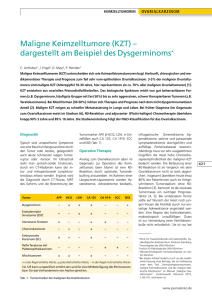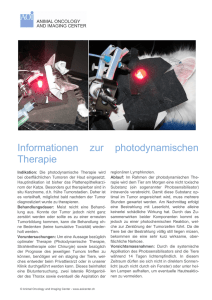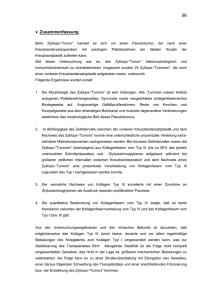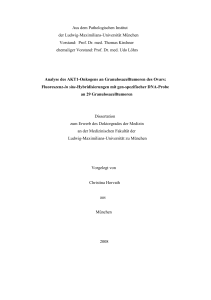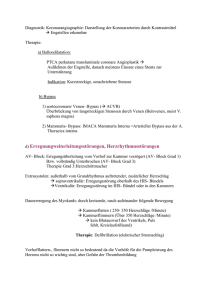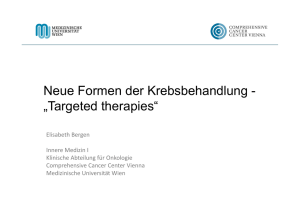Keimstrangstromatumoren
Werbung
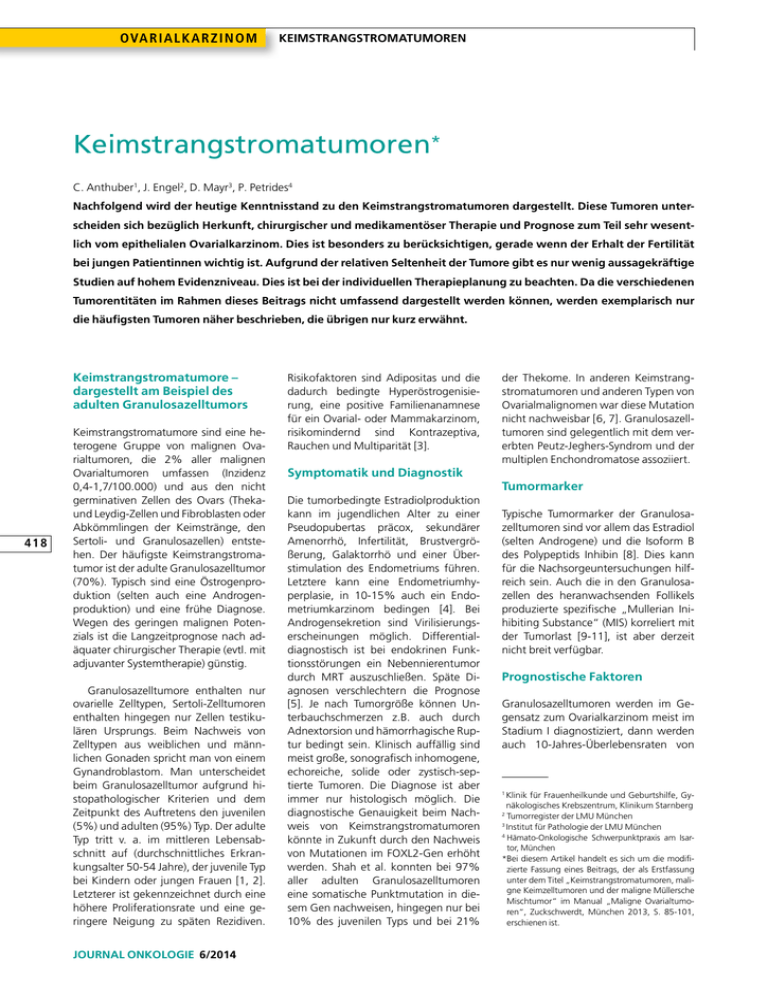
OVARIA L KARZINOM KEIMSTRANGSTROMATUMOREN Keimstrangstromatumoren* C. Anthuber1, J. Engel2, D. Mayr3, P. Petrides4 Nachfolgend wird der heutige Kenntnisstand zu den Keimstrangstromatumoren dargestellt. Diese Tumoren unterscheiden sich bezüglich Herkunft, chirurgischer und medikamentöser Therapie und Prognose zum Teil sehr wesentlich vom epithelialen Ovarialkarzinom. Dies ist besonders zu berücksichtigen, gerade wenn der Erhalt der Fertilität bei jungen Patientinnen wichtig ist. Aufgrund der relativen Seltenheit der Tumore gibt es nur wenig aussagekräftige Studien auf hohem Evidenzniveau. Dies ist bei der individuellen Therapieplanung zu beachten. Da die verschiedenen Tumorentitäten im Rahmen dieses Beitrags nicht umfassend dargestellt werden können, werden exemplarisch nur die häufigsten Tumoren näher beschrieben, die übrigen nur kurz erwähnt. Keimstrangstromatumore – dargestellt am Beispiel des adulten Granulosazelltumors 418 Keimstrangstromatumore sind eine heterogene Gruppe von malignen Ovarialtumoren, die 2% aller malignen Ovarialtumoren umfassen (Inzidenz 0,4-1,7/100.000) und aus den nicht germinativen Zellen des Ovars (Thekaund Leydig-Zellen und Fibroblasten oder Abkömmlingen der Keimstränge, den Sertoli- und Granulosazellen) entstehen. Der häufigste Keimstrangstromatumor ist der adulte Granulosazelltumor (70%). Typisch sind eine Östrogenproduktion (selten auch eine Androgenproduktion) und eine frühe Diagnose. Wegen des geringen malignen Potenzials ist die Langzeitprognose nach adäquater chirurgischer Therapie (evtl. mit adjuvanter Systemtherapie) günstig. Granulosazelltumore enthalten nur ovarielle Zelltypen, Sertoli-Zelltumoren enthalten hingegen nur Zellen testikulären Ursprungs. Beim Nachweis von Zelltypen aus weiblichen und männlichen Gonaden spricht man von einem Gynandroblastom. Man unterscheidet beim Granulosazelltumor aufgrund histopathologischer Kriterien und dem Zeitpunkt des Auftretens den juvenilen (5%) und adulten (95%) Typ. Der adulte Typ tritt v. a. im mittleren Lebensabschnitt auf (durchschnittliches Erkrankungsalter 50-54 Jahre), der juvenile Typ bei Kindern oder jungen Frauen [1, 2]. Letzterer ist gekennzeichnet durch eine höhere Proliferationsrate und eine geringere Neigung zu späten Rezidiven. JOURNAL ONKOLOGIE 6/2014 Risikofaktoren sind Adipositas und die dadurch bedingte Hyperöstrogenisierung, eine positive Familienanamnese für ein Ovarial- oder Mammakarzinom, risikomindernd sind Kontrazeptiva, Rauchen und Multiparität [3]. Symptomatik und Diagnostik Die tumorbedingte Estradiolproduktion kann im jugendlichen Alter zu einer Pseudopubertas präcox, sekundärer Amenorrhö, Infertilität, Brustvergrößerung, Galaktorrhö und einer Überstimulation des Endometriums führen. Letztere kann eine Endometriumhyperplasie, in 10-15% auch ein Endometriumkarzinom bedingen [4]. Bei Androgensekretion sind Virilisierungserscheinungen möglich. Differentialdiagnostisch ist bei endokrinen Funktionsstörungen ein Nebennierentumor durch MRT auszuschließen. Späte Diagnosen verschlechtern die Prognose [5]. Je nach Tumorgröße können Unterbauchschmerzen z.B. auch durch Adnextorsion und hämorrhagische Ruptur bedingt sein. Klinisch auffällig sind meist große, sonografisch inhomogene, echoreiche, solide oder zystisch-septierte Tumoren. Die Diagnose ist aber immer nur histologisch möglich. Die diagnostische Genauigkeit beim Nachweis von Keimstrangstromatumoren könnte in Zukunft durch den Nachweis von Mutationen im FOXL2-Gen erhöht werden. Shah et al. konnten bei 97% aller adulten Granulosazelltumoren eine somatische Punktmutation in diesem Gen nachweisen, hingegen nur bei 10% des juvenilen Typs und bei 21% der Thekome. In anderen Keimstrangstromatumoren und anderen Typen von Ovarialmalignomen war diese Mutation nicht nachweisbar [6, 7]. Granulosazelltumoren sind gelegentlich mit dem vererbten Peutz-Jeghers-Syndrom und der multiplen Enchondromatose assoziiert. Tumormarker Typische Tumormarker der Granulosazelltumoren sind vor allem das Estradiol (selten Androgene) und die Isoform B des Polypeptids Inhibin [8]. Dies kann für die Nachsorgeuntersuchungen hilfreich sein. Auch die in den Granulosazellen des heranwachsenden Follikels produzierte spezifische „Mullerian Inihibiting Substance“ (MIS) korreliert mit der Tumorlast [9-11], ist aber derzeit nicht breit verfügbar. Prognostische Faktoren Granulosazelltumoren werden im Gegensatz zum Ovarialkarzinom meist im Stadium I diagnostiziert, dann werden auch 10-Jahres-Überlebensraten von Klinik für Frauenheilkunde und Geburtshilfe, Gynäkologisches Krebszentrum, Klinikum Starnberg 2 Tumorregister der LMU München 3 Institut für Pathologie der LMU München 4 Hämato-Onkologische Schwerpunktpraxis am Isartor, München *Bei diesem Artikel handelt es sich um die modifizierte Fassung eines Beitrags, der als Erstfassung unter dem Titel „Keimstrangstromatumoren, maligne Keimzelltumoren und der maligne Müllersche Mischtumor“ im Manual „Maligne Ovarialtumoren“, Zuckschwerdt, München 2013, S. 85-101, erschienen ist. 1 KEIMSTRANGSTROMATUMOREN 84-95% erreicht, 50-65% im Stadium II und 17-33% im Stadium III und IV. Nach einer 2007 publizierten Studie von Zhang et al. sind Tumoren bei unter 50 Jährigen prognostisch günstiger [12]. Weitere Prognosefaktoren sind Tumorgröße, Kapselruptur, positiver Aszites, residuale Tumormasse, > 4-10 Mitosen/10 high power fields und das Fehlen von sogenannten Call-ExnerKörperchen [2, 13, 14]. Operative Therapie Entscheidend sind nach LängsschnittLaparotomie die sorgfältige Exploration des Abdomens, Zytologieentnahme, (nach abgeschlossener Familienplanung) Hysterektomie mit beidseitiger Adnexektomie, Omentektomie und die Resektion von auffälligen Peritonealarealen. Die R0-Resektion ist entscheidend, auch bei höheren Tumorstadien. Ein Lymphknotensampling bzw. eine systematische pelvine/ paraaortale Lymphadenektomie ist wegen der Seltenheit positiver Lymphknoten nicht erforderlich [15-18]. Makroskopisch vergrößerte Lymphknoten sollten entfernt werden, v.a. wenn ein anderer histologischer Typ des Ovarialmalignoms vermutet wird. Bei Kinderwunsch ist im Stadium I die unilaterale Adnexektomie ausreichend, das kontralaterale Ovar wird nur bei makroskopischer Auffälligkeit biopsiert (Tumorbefall nur bei 2-8%). Wichtig ist eine diagnostische Hysteroskopie und Abrasio zum Ausschluss eines Endometriumkarzinoms (Östrogenproduktion!). Adjuvante Systemtherapie Die Indikation zu einer adjuvanten Chemotherapie richtet sich nach den genannten prognostischen Faktoren. Im Stadium I sollte nur bei Vorliegen o.g. Risikofaktoren eine adjuvante Therapie erwogen werden. Im Stadium II–IV scheint diese angesichts besserer Überlebenszahlen indiziert zu sein, ein signifikanter Überlebensvorteil wurde aber bisher nicht belegt [2]. Standard sind platinbasierte Chemotherapien (z.B. PVB-Schema bestehend aus Cisplatin, Vinblastin, Bleomycin) [19-22] und das besser verträgliche BEPSchema (Bleomycin, Etoposid, Cisplatin) [21, 23, 24] (Remissionsraten von über 60%). Auch EP (Etoposid und Cisplatin) ist wirksam. Im Rahmen der MAKEIProtokolle wurde PEI (Etoposid, Cisplatin und Ifosfamid) eingesetzt. CAP (Cyclophosphamid, Doxorubicin, Cisplatin) [21, 25-27] zeigte nur im Einzelfall Remissionen. Taxol wird derzeit untersucht. Zur Kombination Carboplatin/Taxol liegen noch keine Daten vor. OVA R I A LKA R Z I N O M im kleinen Becken, aber auch im Oberbauch, Leber, Lunge und Knochen. Wegen der bekannten Spätrezidive bis 40 Jahre nach der Primärtherapie wird heute eine lebenslange Nachsorge in den üblichen Intervallen empfohlen. Initial erhöhte Tumormarker (Hormone, Inhibin) können bestimmt werden. Beim Lokalrezidiv ist eine erneute Systemtherapie nach Tumordebulking (R0!) sinnvoll, insbesondere nach langem krankheitsfreien Intervall. Auch eine platinbasierte Chemotherapie und/oder Strahlentherapie sind möglich [30]. Antihormonelle Therapien sind derzeit noch als experimentell zu betrachten [31-35]. Auf weitere seltenere Keimstrangstromatumoren (reiner Sertoli-Tumoren, reiner Leydig-Tumor, Thekome, Fibrome, Fibrosarkom, Gynandroblastom, Keimstrangstromatumore mit annulären Tubuli) wird aus Kapazitätsgründen hier nicht näher eingegangen. AUTO R Radiatio Prof. Dr. med. Christoph Anthuber Granulosazelltumoren sind strahlensensibel, allerdings liegen auch zur postoperativen Bestrahlung keine prospektiven Studien vor. Komplette Remissionen sind durchaus möglich [21, 28, 29]. Klinik für Frauenheilkunde und Geburtshilfe Gynäkologisches Krebszentrum Klinikum Starnberg Oßwaldstr.1 82319 Starnberg Behandlung der Rezidive Tel.: 08151/182 310 Fax: 08151/182 327 E-Mail: [email protected] Granulosazelltumoren rezidivieren nach durchschnittlich 4-6 Jahren vor allem Literatur 1.Malmstrom H, Hogberg T, Risberg B, Si- 3.Boyce EA, Constaggini I, Vitonis A. The epidemio- 6.Shah SP, Köbel M, Senz J et al. Mutation monsen E. Granulosa cell tumors of the logy of ovarian granulosa cell tumors: a case con- of FOXL2 in granulosa-cell tumors in the ovary: prognostic factors and outcome. trol study. Gynecol Oncol 2009; 115:221-225. Gynecol Oncol 1994; 52:50-55. 2.Hölscher G, Anthuber Ch, Bastert G et al. The project group „Malignant Ovarian Tu- ovary. N Engl J Med 2009; 360:2719-2729. 4.Koksal Y, Reisli I, Gunel E et al. Galactorrhea- 7.Kölbel M, Gilks CB, Huntsman DG. Adult- associated granulosa cell tumor in a child. type granulosa cell tumor and FOXL2 mu- Pediatr Hematol Oncol 2004; 21:101-106. tation. Cancer Res 2009; 69(24):9160-2. mors“ of the Munich Cancer Center (MCC): 5.Kalfa N, Patte C, Orbach D et al. A nation- 8.Mom CH, Engelen MJ, Willemse PH et al. Improvement of survival in sex cord stromal wide study of granulosa cell tumors in pre- Granulosa cell tumor of the ovary: The cli- tumors – an observational study with more and postpubertal girls: missed diagnosis of nical value of serum Inhibin A and B levels than 25 years follow-up. Acta Obstetrica et endocrine manifestations worsens prognosis. in a large single center cohort. Gynecol On- Gynecologica 2009; 88:440-448. J Pediatr Endocrinol Metab 2005; 18:25-31. col 2007; 105:365-372. www.journalonko.de 419 OVARIA L KARZINOM 9.Rey RA, Lhomme C, Marcillac I et al. Anti- 21.Savage P, Constenla D, Fisher C et al. Gra- 28.Wolf JK, Mullen J, Eifel PJ et al. Radiation mullerian hormone as a serum marker of nulosa cell tumours of the ovary: demogra- treatment of advanced or recurrent granu- granulosa cell tumors of the ovary: com- phics, survival and the management of ad- losa cell tumor of the ovary. Gynecol Oncol parative study with serum alpha-inhibin vanced disease. Clin Oncol (R Coll Radiol) and estradiol. Am J Obstet Gynecol 1996; 1998; 10:242-245. 1999; 73:35-41. 29.Hirakawa M, Nagai Y, Yagi C et al. Re- 22.Zambetti M, Escobedo A, Pilotti S, De Palo G. current juvenile granulosa cell tumor 10.Lane AH, Lee MM, Fuller AF Jr et al. Dia- Cisplatinum/vinblastine/bleomycin combi- of the ovary managed by palliative ra- gnostic utility of Mullerian inhibiting sub- nation chemotherapy in advanced or re- diotherapy. Int J Gynecol Cancer 2008; stance determination in patients with pri- current granulosa cell tumors of the ovary. mary and recurrent granulosa cell tumors. Gynecol Oncol 1990; 36:317-320. 174:958-965. Gynecol Oncol 1999; 73:51-55. 18:913-915. 30.Uygun K, Aydiner A, Saip P et al. Clinical 23.Gershenson DM, Morris M, Burke TW parameters and treatment results in recur- 11.Chang HL, Pahlavan N, Halpern EF, Ma- et al. Treatment of poor-prognosis sex rent granulosa cell tumor of the ovary. Gy- cLaughlin DT. Serum Mullerian inhibiting cord-stromal tumors of the ovary with Substance/Anti-Mullerian hormone levels the combination of bleomycin, eto- 31.Briasoulis E, Karavasilis V, Pavlidis N. Me- in patients with adult granulosa cell tumors poside, and cisplatin. Obstet Gynecol gestrol activity in recurrent adult type gra- directly correlate with aggregate tumor 1996; 87:527-531. nulosa cell tumour of the ovary. Ann Oncol mass as determined by pathology or radiology 2009; 114:57-60. 24.Homesley HD, Bundy BN, Hurteau JA, Roth necol Oncol 2003; 88:400-403. 1997; 8:811-812. LM. Bleomycin, etoposide, and cisplatin 32.Fishman A, Kudelka AP, Tresukosol D 12.Zhang M, Cheung MK, Shin JY et al. Pro- combination therapy of ovarian granulosa et al. Leuprolide acetate for treating gnostic factors responsible for survival in cell tumors and other stromal malignan- refractory or persistent ovarian granu- sex cord-stromal tumors of the ovary – An cies: A Gynecologic Oncology Group study. losa cell tumor. J Reprod Med 1996; analysis of 376 women. Gynecol Oncol 2007; 104:396. 13.Lee YK, Park NH, Kim JW et al. Characteristics of recurrence in adult-type granulosa cell tu- 420 KEIMSTRANGSTROMATUMOREN Gynecol Oncol 1999; 72:131-137. 41:393-396. 25.Camlibel FT, Caputo TA. Chemotherapy of 33.Martikainen H, Penttinen J, Huhtaniemi I, granulosa cell tumors. Am J Obstet Gyne- Kauppila A. Gonadotropin-releasing hor- col 1983; 145:763-765. mone agonist analog therapy effective in mor. Int J Gyneco Cancer 2008; 18:642-647. 26.Gershenson DM, Copeland LJ, Kavanagh JJ 14.Ranganath R, Sridevi V, Shirley SS, Shantha et al. Treatment of metastatic stromal tu- V. Clinical and pathologic prognostic factors mors of the ovary with cisplatin, doxorubi- 34.Schwartz PE, Smith JP. Treatment of ova- in adult granulosa cell tumors of the ovary. cin, and cyclophosphamide. Obstet Gyne- rian stromal tumors. Am J Obstet Gynecol Int J Gynecol Cancer 2008; 18:929-933. col 1987; 70:765-769. ovarian granulosa cell malignancy. Gynecol Oncol 1989; 35:406-408. 19976; 125:402-411. 15.Schumer ST, Cannistra SA. Granulosa cell 27. Kaye SB, Davies E. Cyclophosphamide, 35. Tao X, Sood AK, Deavers MT et al. tumor of the ovary. J Clin Oncol 2003; adriamycin, and cisplatinum for the treat- Anti-angiogenesis therapy with Beva- 21:1180-1189. ment of advanced granulosa cell tumor, cizumab for patients with ovarian gra- using serum estradiol as a tumor marker. nulosa cell tumors. Gynecol Oncol 2009; Gynecol Oncol 1986; 24:261-264. 114(3):431-436. 16.Gershenson DM. Sex cord-stromal tumors of the ovary: granulosa-stromal cell tumors. Literatur Review “up to date”: Last version January 26, 2010. 17.Abu-Rustum NR, Restivo A, Ivy J. Retroperitoneal nodal metastasis in primary and recurrent granulosa cell tumor of the ovary. Gynecol Oncol 2006; 103:31-34. 18.Brown J, Sood AK, Deavers MT. Patterns of metastasis in sex cord stromal-tumors of the ovary. Gynecol Oncol 2009; 113:86. 19. Colombo N, Sessa C, Landoni F et al. Cisplatin, vinblastine, and bleomycin combination chemotherapy in metastatic granulosa cell tumor of the ovary. Obstet Gynecol 1986; 67:265-268. 20.Pecorelli S, Wagenaar HC, Vergote IB et al. Cisplatin (P), vinblastine (V) and bleomycin (B) combination chemotherapy in recurrent or advanced granulosa(-theca) cell tumours of the ovary. An EORTC Gynaecological Cancer Cooperative Group study. Eur J Cancer 1999; 35:1331-1337. JOURNAL ONKOLOGIE 6/2014 A B STR AC T C. Anthuber1, J. Engel2, D. Mayr3, P. Petrides4 2-5% of all malignant ovarian tumors are sex cord stroma tumors and germ cell tumors. Sex cord stroma tumors arise from the non-germinative cells of the ovary (theca cells, leydig cells, fibroblasts) or are derived from the sex cords (sertoli-cells and granulosa cells). All these tumors produce estrogens except the fibroma. The production of androgenes is also possible, but rare. In contrast to the epithelial ovarian cancer these tumors are often diagnosed at an early stage. They have only a low malignant potential, long-term prognosis is quite good. The following article describes the adult granulosa-cell tumor as the most common form of sex-cord-stroma tumor. Klinik für Frauenheilkunde und Geburtshilfe, Gynäkologisches Krebszentrum, Klinikum Starnberg Tumorregister der LMU München 3 Institut für Pathologie der LMU München 4 Hämato-Onkologische Schwerpunktpraxis am Isartor, München 1 2 Keywords: sex cord stroma tumors, low malignant potential
